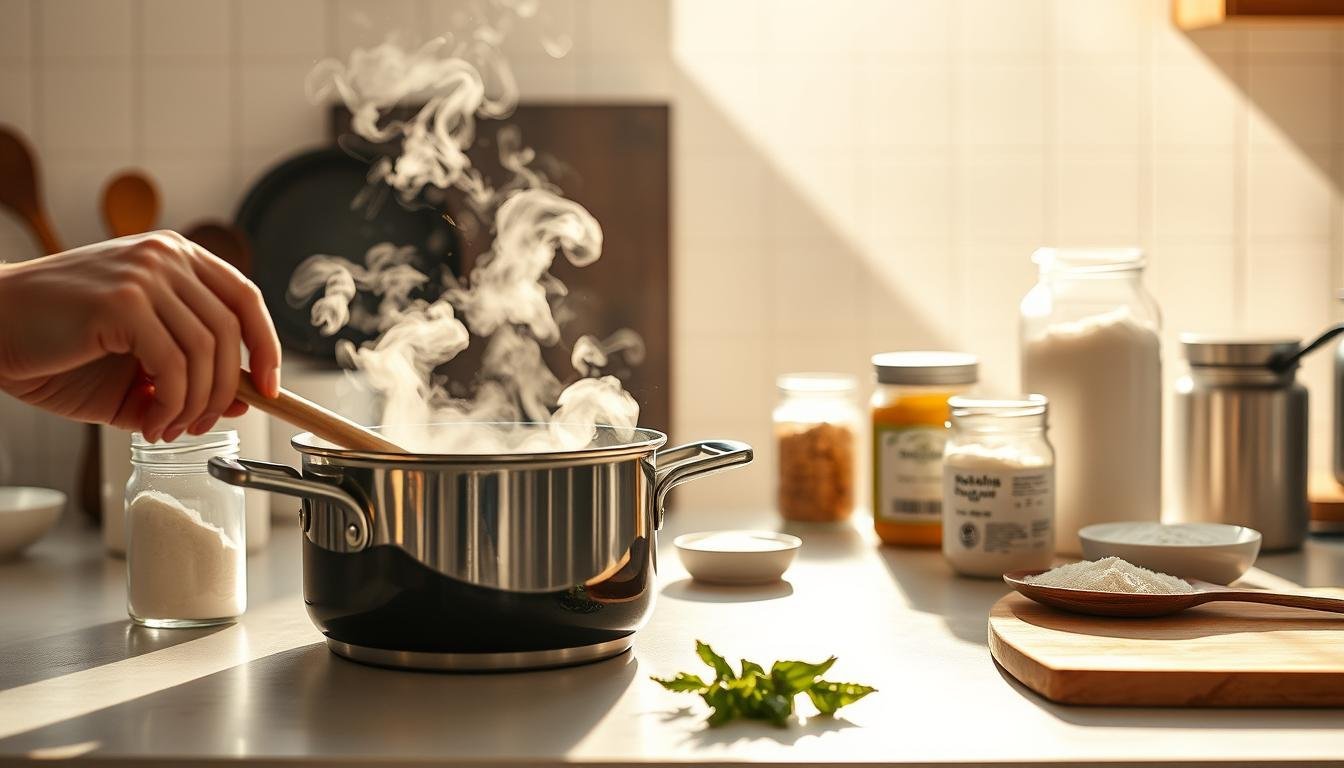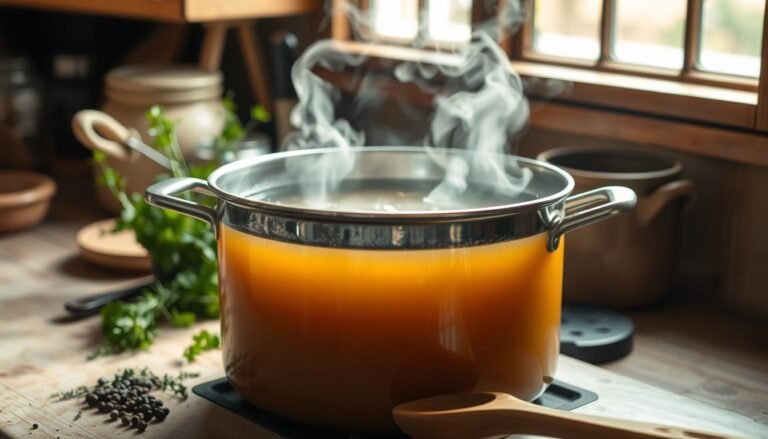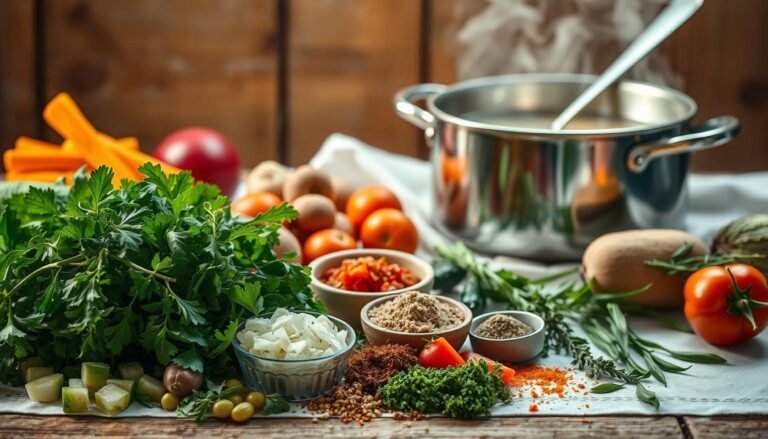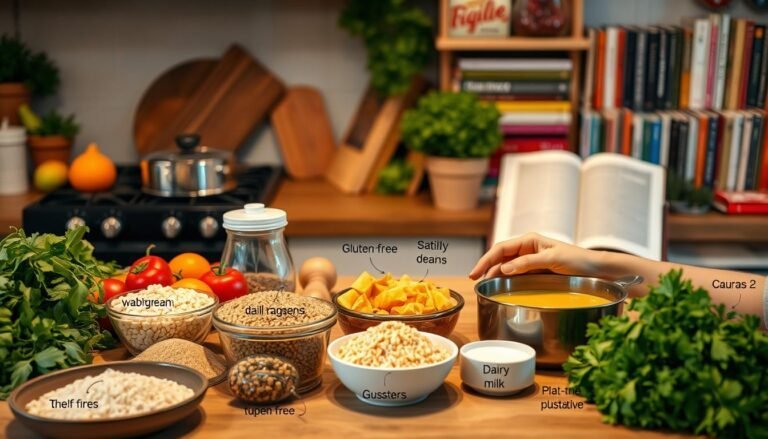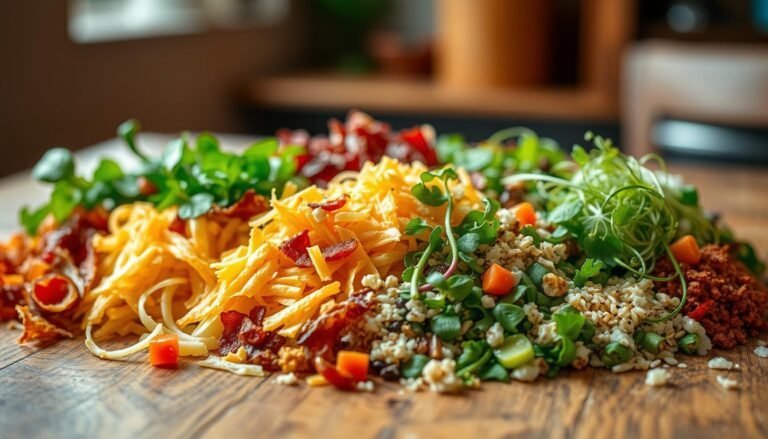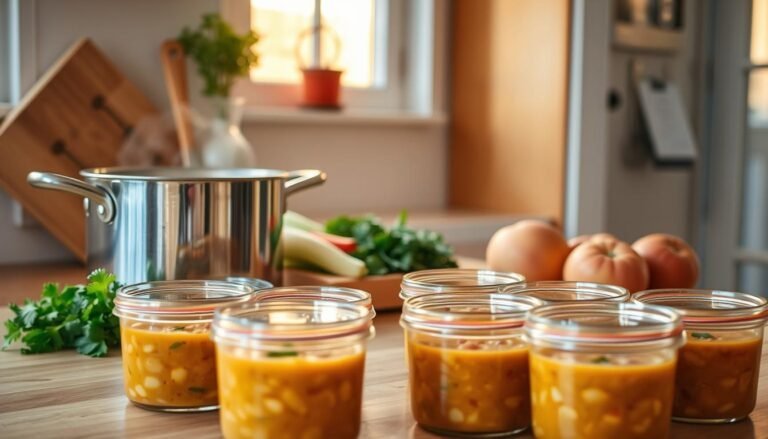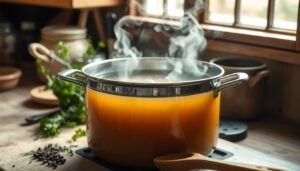Disclosure: This Post Contains Affiliate Links; We earn a commission on purchases.
Getting the right soup consistency is key for a great soup experience. If your broth is too thin or your soup too thick, it can be tricky to fix.
Soup thickening techniques and soup thinning methods are vital for soup lovers. You can use starches, dairy, or puréed ingredients to change the soup’s texture.
With these easy methods, you can make your soup a true delight. The trick is to know the different ways and use them well.
Key Takeaways
- Understand the importance of achieving the right soup consistency.
- Learn various soup thickening techniques.
- Discover effective soup thinning methods.
- Explore the use of starches, dairy, and puréed ingredients.
- Apply simple techniques to adjust soup consistency.
Understanding Soup Consistency
The texture of soup is very important. It makes the soup more enjoyable to eat. A good consistency can make your meal better.
Why Texture Matters in Soup Making
The texture of soup changes how we taste it. A thin soup might taste bland. A thick soup can be too much. A good texture makes the soup taste better.
Identifying When Your Soup Needs Adjustment
You need to know when your soup needs to be thicker or thinner. Look at how it looks when it cools or when you serve it.
Signs of Too-Thin Soup
If your soup looks too watery, it’s too thin. You can use thickening agents like flour or starch to fix it.
Signs of Over-Thickened Soup
A soup that’s too thick is hard to spoon. To fix it, add more liquid like broth or water.
Basic Kitchen Tools for Consistency Control
Having the right tools helps adjust soup consistency. Tools like immersion blenders, whisks, and measuring cups are key for making changes.
Quick and Easy Ways to Thicken or Thin Soup
Soup lovers rejoice! Adjusting your soup’s consistency is easy. Whether it’s too watery or too thick, there are quick fixes.
Last-Minute Fixes for Watery Soups
For watery soups, try a couple of quick fixes. 5-Minute Thickening Solutions include mixing starches like cornstarch or tapioca flour with water. Then add it to the soup.
5-Minute Thickening Solutions
- Mix 1 tablespoon of cornstarch with 2 tablespoons of water until smooth.
- Add the mixture to your soup and stir well.
- Wait for about 5 minutes to allow the soup to thicken.
Techniques That Don’t Require Additional Cooking
Some methods don’t need extra cooking. Using puréed ingredients or adding a roux works well. Puréeing a portion of the soup thickens it and boosts flavor.
Rapid Methods to Thin Overly Thick Soups
If your soup is too thick, thin it out quickly. Liquid Additions That Preserve Flavor are key. Adding a bit of broth or water thins it without losing flavor.
Liquid Additions That Preserve Flavor
- Add a small amount of broth or water.
- Stir well and check the consistency.
- Adjust as needed.
Stirring and Heating Techniques
Stirring and heating also thin out soup. Gently heat the soup while stirring to get the right consistency.
These quick and easy methods let you adjust your soup’s consistency. Enjoy a perfect dining experience.
Powerful Thickening Agents and Methods
Getting the right soup consistency is key. There are many ways to do this, from using flour to natural foods.
Flour-Based Thickeners
Flour-based thickeners are a top pick for soup texture. They soak up extra liquid and make the soup thicker.
Making and Using a Roux
A roux is flour and fat cooked together. It makes the soup smooth and creamy. Mix equal parts flour and fat in a pan and cook until it’s the right color.
Working With Beurre Manié
Beurre manié is butter and flour mixed together. It adds a creamy texture to soups without long cooking times.
Starch Thickeners
Starch thickeners are a good alternative to flour. They are gluten-free and great for changing soup texture.
Cornstarch Slurry Technique
A cornstarch slurry is cornstarch mixed with cold water or broth. Add it to the soup to thicken it without changing the taste.
Potato, Rice, and Other Starch Options
Potato starch, rice flour, and tapioca starch can also thicken soups. They offer different textures and tastes, helping you find the perfect match for your soup.
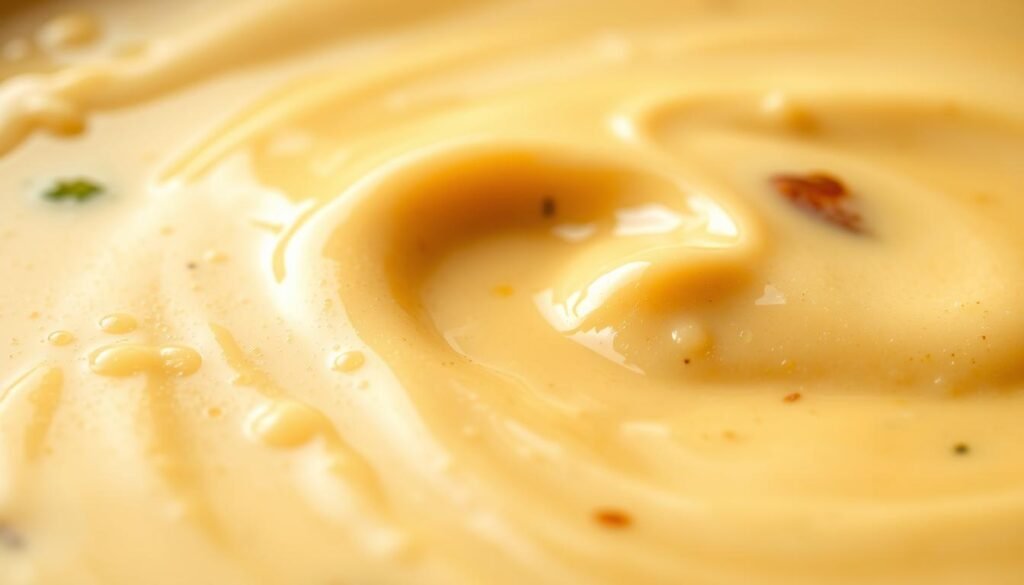
Natural Food Thickeners
For a natural way to thicken soups, there are several options.
Puréed Vegetables
Puréed veggies can make soups thicker and tastier. Just cook the veggies until soft, then blend them into the soup.
Beans and Legumes
Beans and legumes are great for thickening soups naturally. Cook and purée them to add thickness and nutrition to your meal.
Effective Techniques for Thinning Soups
Thinning soup can be tricky, but the right methods can help. You can make your soup just right without losing flavor. Whether it’s too thick or you like it thinner, there are ways to fix it.
Liquid Additions
Adding liquids is a simple way to thin out soup. The liquid you choose can change the soup’s taste and feel.
Broths and Stocks
Using broth or stock is a great way to thin soup. It keeps the flavor strong because broths and stocks are similar to the soup.
Water, Wine, and Cream Options
For different soups, you can use water, wine, or cream. Water won’t change the taste. Wine adds depth. Cream makes the soup richer and thinner.

Dilution Methods That Maintain Flavor
Keeping the flavor when thinning soup is important. There are ways to do this.
Gradual Thinning Technique
Thinning soup slowly is key. Start with a little liquid, stir, and check. Keep adding and stirring until it’s right.
Rebalancing Seasonings After Thinning
After thinning, you need to rebalance the seasonings. Adding liquid can weaken the flavors. You might need to add more salt, herbs, or spices.
Here are some tips for thinning soups:
- Start with small amounts of liquid to avoid making it too thin.
- Stir well after each addition to keep it even.
- Check and adjust the seasonings after thinning.
Troubleshooting Common Soup Consistency Problems
Soup lovers often face consistency issues. But, these problems can be fixed with the right techniques. Whether it’s a broken soup, unwanted texture, or adjusting consistency for different soups, there are solutions.
Fixing Broken or Separated Soups
Broken or separated soups can be a letdown. To fix this, whisk in a bit more broth or cream. Or, use an immersion blender to blend the soup and mix the ingredients again.
Rescuing Gummy or Pasty Textures
Gummy or pasty textures come from over-thickening. To fix, thin the soup with more broth or water. Add the liquid slowly and stir well to get the right consistency.
Adjusting Consistency for Different Types of Soups
Different soups need different consistencies. For example, cream-based soups should be rich and thick. Broth-based soups should be more fluid. Pureed vegetable soups are in between.
Cream-Based Soups
To adjust cream-based soups, add more cream or a roux to thicken. Or, add a bit of broth to thin.
Broth-Based Soups
For broth-based soups, add more broth to thin. Or, simmer to reduce and thicken.
Pureed Vegetable Soups
Pureed vegetable soups can be thinned with broth or water. Or, add more vegetables or a starch to thicken.
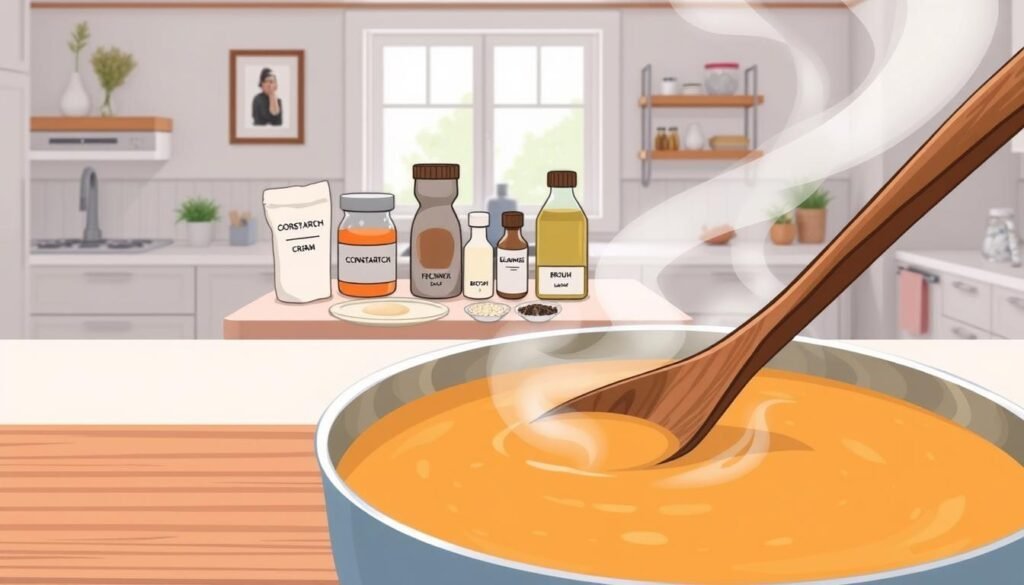
Mastering Soup Consistency: A Simple yet Effective Approach
Getting the perfect soup consistency is all about knowing the right techniques. It’s also about picking the right thickening agents or thinning methods. There are many ways to adjust soup texture, whether it’s too watery or too thick.
Methods like blending, adding cream or yogurt, and using flour or cornflour are easy to try. If your soup is too thick, you can thin it out with liquids. For more tips on thickening soups, check out BBC Good Food.
With these simple techniques, you can make your soups better. Whether you’re new to cooking or have lots of experience, you can get the soup consistency just right.
FAQ
What are some common thickening agents used in soups?
How can I thicken a watery soup quickly?
What is the best way to thin out a thick soup without altering its flavor?
How do I prevent my soup from becoming too thick when using thickening agents?
Can I use dairy products to thicken soups, and if so, how?
What are some tips for adjusting soup consistency for different types of soups?
How can I rescue a soup that has become too gummy or pasty?
What are some effective dilution methods for thinning soups while maintaining flavor?

Ryan Conlon is the comfort food fan behind QuickSimpleSoups.com, where he shares easy soup ideas, smart shortcuts, and helpful tips for busy home cooks. Ryan believes a good bowl of soup doesn’t need to be complicated—and he’s here to prove it. Whether you’re looking for quick weeknight meals or cozy classics with a twist, Ryan’s simple approach helps you serve up satisfying soups with minimal effort.
Subscribe to Our Newsletter

